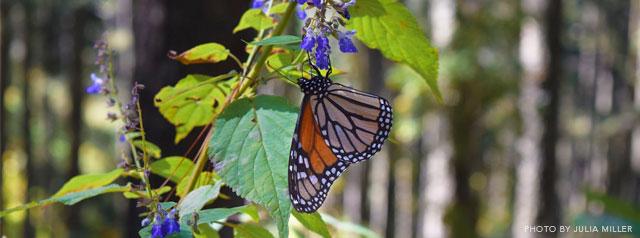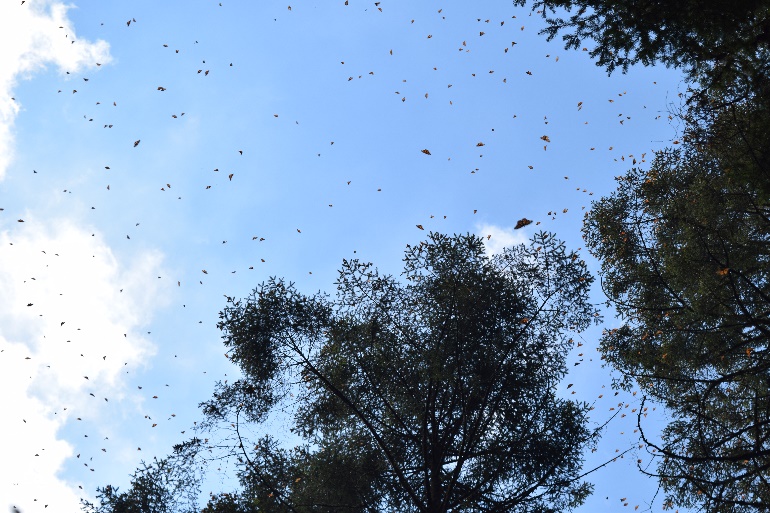The Holbrook Explorer

Guest post: Reflections on Monarch Conservation and Mexico
Guest post: Reflections on Monarch Conservation and Mexico
After returning from her trip to Mexico with the Florida Museum of Natural History in February, butterfly conservationist Julia Miller shared her reflections on the experience, and ways to continue advancing conservation efforts for migrating Monarchs. Read her guest blog post below, and make sure to check out the last section for her recommendations on how to get involved in conservation!
Monarch Butterfly (Danaus plexippus) Migration and Restoration
As a biology graduate and nature lover, conservation has always been something I value for the importance of our environments, of species biodiversity, and of human health.
From my experience with teaching, maintenance, and husbandry in the butterfly exhibit at the North Carolina Aquarium at Fort Fisher, my interest in butterflies was sparked, and I knew that I had to visit the overwintering sites in Mexico at some point in my life. This past February I joined a group with the Florida Museum of Natural History and Holbrook Travel on a trip to visit the remarkable Monarch butterfly overwintering sanctuaries of El Rosario and Sierra Chincua.

The explosion of butterflies, thousands and thousands, millions, glide between treetops against a gorgeous blue sky
It was here where I witnessed the migration destination of Monarch butterflies. It was beyond magical to see the sheer numbers of butterflies and to witness their behavior! How they huddle together on the oyamel fir tree branches for warmth and how they rapidly disperse once the sun intensifies in the afternoon was breathtaking. During their period here, the butterflies’ systems succumb to fascinating overwintering diapause, or dormancy, and then yield to the beginnings of their reproductive behavior for the next generation to begin the flight north.
The butterflies migrate south from parts through the United States and Canada from September to November, making stops in roosts along the way in correlation with time of day, weather, body condition, energy reservation, and gathering nectar.

Glorious, huge, chrysalis-like sacs of leaves, but NO, they are Monarch Butterflies!
The Monarch numbers appeared high up in the mountains when visiting, but numbers and their migration are threatened due to the following assembly of factors to name a few: pesticides and herbicides, disease, climate change, habitat loss, and lack of milkweed host plants. Without the assistance of the communities in Mexico and throughout the migration routes of the United States, the protection of the migration of the species would be limited.
Luckily, conservation efforts through reserves and sanctuaries, eco-tourism, law, and sustainability practices are helpful, but what else can one do to support the Monarchs?
The term restoration was brought to my attention as being the new conservation. I began thinking on the difference in the terms. Is restoration a conservation tool? Perhaps it is something that works hand in hand with conservation to ensure future survival and abundance. According to the Society for Ecological Restoration, ecological restoration is defined as “intentional activity that initiates or accelerates the recovery of an ecosystem with respect to its health, integrity and sustainability.” As we conserve habitats and wildlife, we also need to take initiative to restore species and habitats through erosion control, reforestation, removal of non-native species and reintroduction of native species, and revegetation.

This female butterfly takes a moment away from the group to refuel from a nectar-producing plant
What can I do to support Monarch conservation?
1. Education
When you pass around what you know and find fascinating, that passion comes across and sparks and inspires others to appreciate and to conserve. Share any butterfly and/or pollinator knowledge with others - family, friends, school clubs, garden clubs, zoos, aquariums, universities, blogs, social media.
Quick fact! The fourth-generation Monarch that makes the 3,000-mile journey lives four times longer (living months long versus a couple of weeks)! Pass it on.
2. Plant native, pesticide free, and proper milkweed plants for Monarchs (many milkweed species produce cardenolides and alkolides that are too toxic)
Native Milkweeds for Eastern United States: Butterfly Milkweed (Asclepias tuberosa), Swamp Milkweed (Asclepias incarnata), Common Milkweed (Asclepias syriaca), Purple Milkweed (Asclepias purpurascens), Poke Milkweed (Asclepias exaltata), and Whorled Milkweed (Asclepias verticillate)
Make sure to ask for native milkweeds at your local garden center.
3. Butterfly highways
Any garden space with nectar-producing and host plants all make up the butterfly highways that link together habitat for pollinators. As Monarch butterflies migrate, they need these spaces to rest and to receive nourishment.
Many milkweeds do well in well-drained soils, fields, and roadsides (also linking the butterfly highway name).
Planting helps prevent soil erosion, increases biodiversity and creates healthy habitats, improves water quality, helps with pest control, and is beautiful!
Charlotte, North Carolina, about three hours from where I live in Raleigh, has put together a butterfly highway group, planting milkweeds and native flowering plants in public spaces. You can too! It is a great way to get communities involved!
4. Gardens
Plant both host plants for the butterflies to lay their eggs on and for the caterpillars to consume such as milkweed for Monarch butterflies, dill, or clover as well as nectar-producing plants such as Lantana (My favorite! They smell so good!),
For other butterfly gardening ideas, check out this blog article I wrote when I was working in the Butterfly Bungalow at the NC Aquarium at Fort Fisher.
5. Support MonarchWatch.org, non-profits, museums, conservation trips
Monarchwatch.org - Anything you could ever want to know and help with, to support Monarchs!
Aquariums such as the North Carolina Aquarium at Fort Fisher, museums such as the Florida Museum, and travel trips such as my Migrating Monarch trip with Holbrook Travel that support the conservation and restoration of ecosystems and their inhabitants (Monarchs!) are looking for your support to drive their mission.

References
- Environment and Ecology. Restoration Ecology. Retrieved March 9, 2020, from http://environment-ecology.com/what-is-ecology/140-restoration-ecology.html.
- Holbrook Travel and Florida Museum of Natural History led by Andrei Sourakov. (2020). Mexico. Monarch Migration.
